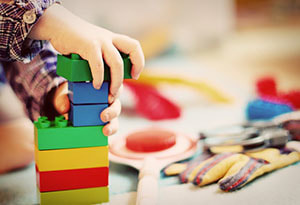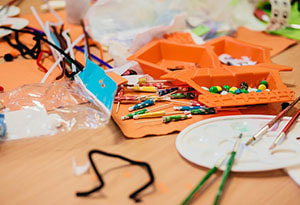
Does your child get frustrated easily?
It doesn’t matter if they are doing homework, trying to get dressed by themselves, playing video games, or playing with friends or siblings, your child is frustrated. Their frustration may look like a complete melt down with tears or really angry, complete with yelling and throwing things. Most likely, in the end, your child feels like giving up. As a parent, I have seen this first hand with my oldest child and as a play therapist, I see this very often in my office. Watching your beautiful, smart child give up on something that seems easily fixable to you can be heart breaking and make you feel as frustrated yourself.
So, how can you help your child solve everyday problems, which will then help them solve bigger problems later in life?
It doesn’t matter if they are doing homework, trying to get dressed by themselves, playing video games, or playing with friends or siblings, your child is frustrated. Their frustration may look like a complete melt down with tears or really angry, complete with yelling and throwing things. Most likely, in the end, your child feels like giving up. As a parent, I have seen this first hand with my oldest child and as a play therapist, I see this very often in my office. Watching your beautiful, smart child give up on something that seems easily fixable to you can be heart breaking and make you feel as frustrated yourself.
So, how can you help your child solve everyday problems, which will then help them solve bigger problems later in life?
It may seem like a very structured plan will be the most helpful way to assist your child in problem solving. And in fact, there are some wonderful tools you can use to do just that (Worksheet 1 and Worksheet 2). However, something that I have witnessed over and over in my office is that children who struggle with problem solving also really struggle to use their imagination. One example of this is a child who initiates a play sword fight with me in my office and gives up the minute I block an attack or touch them with my sword. Or another child who crumples up their drawing because they accidentally colored the tree trunk purple instead of brown. In the first example, a child with a well-developed imagination might create a force field around themselves that my sword cannot penetrate or will create a healing potion that allows them to magically come back to life. In the second example, the child might decide that this type of tree only grows on an island far, far away. With either child, if they have a well-developed imagination, they are able to solve the problem in a way that allows them to be at peace with the situation. If children are struggling to come up with solutions during their play, they will likely struggle to come up with solutions in other “real-life” situations.
So how do I help my child engage their imagination? If you’re worried that you will have to use your imagination yourself, well, you will. Children learn through modeling the important people around them, as well as through free play. If this thought is difficult for you, think about the new trend in businesses today…creativity and innovation. You can’t have either without a healthy imagination. “Without imagination, people cannot look at problems from new perspectives,” (Baumgartner, J. 2004). Not only will you be building your child’s problem-solving skills, but you will be helping your own as well and may make yourself more marketable in the future. Another benefit of playing imaginatively with your child is that it helps improve their feeling of connection to you and may decrease any negative behaviors they exhibit around the home.
To get started, it is important to have some tools (toys, art materials, etc.) available to your child. It is important to see what your child naturally gravitates to, so that you are not forcing your ideas onto them. Below is a short list of ideas of tools to have available:
So how do I help my child engage their imagination? If you’re worried that you will have to use your imagination yourself, well, you will. Children learn through modeling the important people around them, as well as through free play. If this thought is difficult for you, think about the new trend in businesses today…creativity and innovation. You can’t have either without a healthy imagination. “Without imagination, people cannot look at problems from new perspectives,” (Baumgartner, J. 2004). Not only will you be building your child’s problem-solving skills, but you will be helping your own as well and may make yourself more marketable in the future. Another benefit of playing imaginatively with your child is that it helps improve their feeling of connection to you and may decrease any negative behaviors they exhibit around the home.
To get started, it is important to have some tools (toys, art materials, etc.) available to your child. It is important to see what your child naturally gravitates to, so that you are not forcing your ideas onto them. Below is a short list of ideas of tools to have available:
- Blank paper/drawing utensils
- Random craft items (toilet paper tubes, glue, popsicle sticks, etc)
- Play dough
- Blocks, Legos, Linkin-logs, etc.
- Characters (typically, the more generic/no-named are apt to make the child’s imagination muscles work harder)
- Animals/dinosaurs
- Story Cubes
- Books with imaginative stories (Dr. Seuss for example)
- Costumes

And now, let the play begin. Follow their lead. If they choose to play with dinosaurs, notice how they are playing. Do they line them up in row? Place them in categories? If they are not showing many signs of using their imagination during their play, go slow. Maybe help them line the dinosaurs up by having them walk like a dinosaur to the line and growl. See how they react. Then increase your imaginative play as you go. Pay attention to your child’s cues. If you are play fighting with the dinosaurs and they are getting frustrated that you messed up their neat rows, take a step back. You are not doing anything wrong, you are assessing your child’s comfort level with this new form of play. There are so many ways to add creativity to your day to help improve this skill for you child. Use different voices when you read them stories. Or better yet, create a bedtime story with them. Let them create whatever they want out of random craft materials as you create something right along-side them. Costumes are a great way to instantly create a different world for your child. If they still seem to struggle making up a scenario, put on that cowboy hat that is too small and jump in with them.
Exhausted from playing? Especially if you are playing the same game over and over? You will be happy to know that allowing time for free play is also a great way to help children build their imagination. If your child is not used to entertaining themselves without the use of a screen, be ready for some resistance. The end result of providing the opportunity for your child to play freely with toys will outweigh the initial resistance. The tools listed above can be the same tools used for free play. When you get the, “I’m bored. There is nothing to do,” comments, take out a box of random craft stuff or the Linkin-logs, put it on the table and tell them to figure something out. Will they fight you? Yes. Will they think you’re lame? Absolutely. Will they learn to enjoy it over time? Most likely they will, and it is providing them the tools to solve the bigger problems later in life.
Another way to increase their awareness of problem solving skills and thinking outside of the box is narrating your process as you work through a problem. “Hmm, that didn’t work. That’s frustrating. What if I look at it in a different way.” Or “There are probably a lot of different ways for me to figure this out. What should I try first?” Your child will watch you and learn from you. If they see you doing this in everyday life, they are more likely to engage as you help them find new solutions to their problems.
By building their skills now, they are more likely to look outside of the box for solutions in the future. It also gives you a wonderful opportunity to share fun and silly moments with your children to help strengthen your connection.
Baumgartner, J. (November 23,2004) “Imagination: The Number One Tool for Innovation and Creativity.” Retrieved from www.innovationmanagement.se
Exhausted from playing? Especially if you are playing the same game over and over? You will be happy to know that allowing time for free play is also a great way to help children build their imagination. If your child is not used to entertaining themselves without the use of a screen, be ready for some resistance. The end result of providing the opportunity for your child to play freely with toys will outweigh the initial resistance. The tools listed above can be the same tools used for free play. When you get the, “I’m bored. There is nothing to do,” comments, take out a box of random craft stuff or the Linkin-logs, put it on the table and tell them to figure something out. Will they fight you? Yes. Will they think you’re lame? Absolutely. Will they learn to enjoy it over time? Most likely they will, and it is providing them the tools to solve the bigger problems later in life.
Another way to increase their awareness of problem solving skills and thinking outside of the box is narrating your process as you work through a problem. “Hmm, that didn’t work. That’s frustrating. What if I look at it in a different way.” Or “There are probably a lot of different ways for me to figure this out. What should I try first?” Your child will watch you and learn from you. If they see you doing this in everyday life, they are more likely to engage as you help them find new solutions to their problems.
By building their skills now, they are more likely to look outside of the box for solutions in the future. It also gives you a wonderful opportunity to share fun and silly moments with your children to help strengthen your connection.
Baumgartner, J. (November 23,2004) “Imagination: The Number One Tool for Innovation and Creativity.” Retrieved from www.innovationmanagement.se


 RSS Feed
RSS Feed
